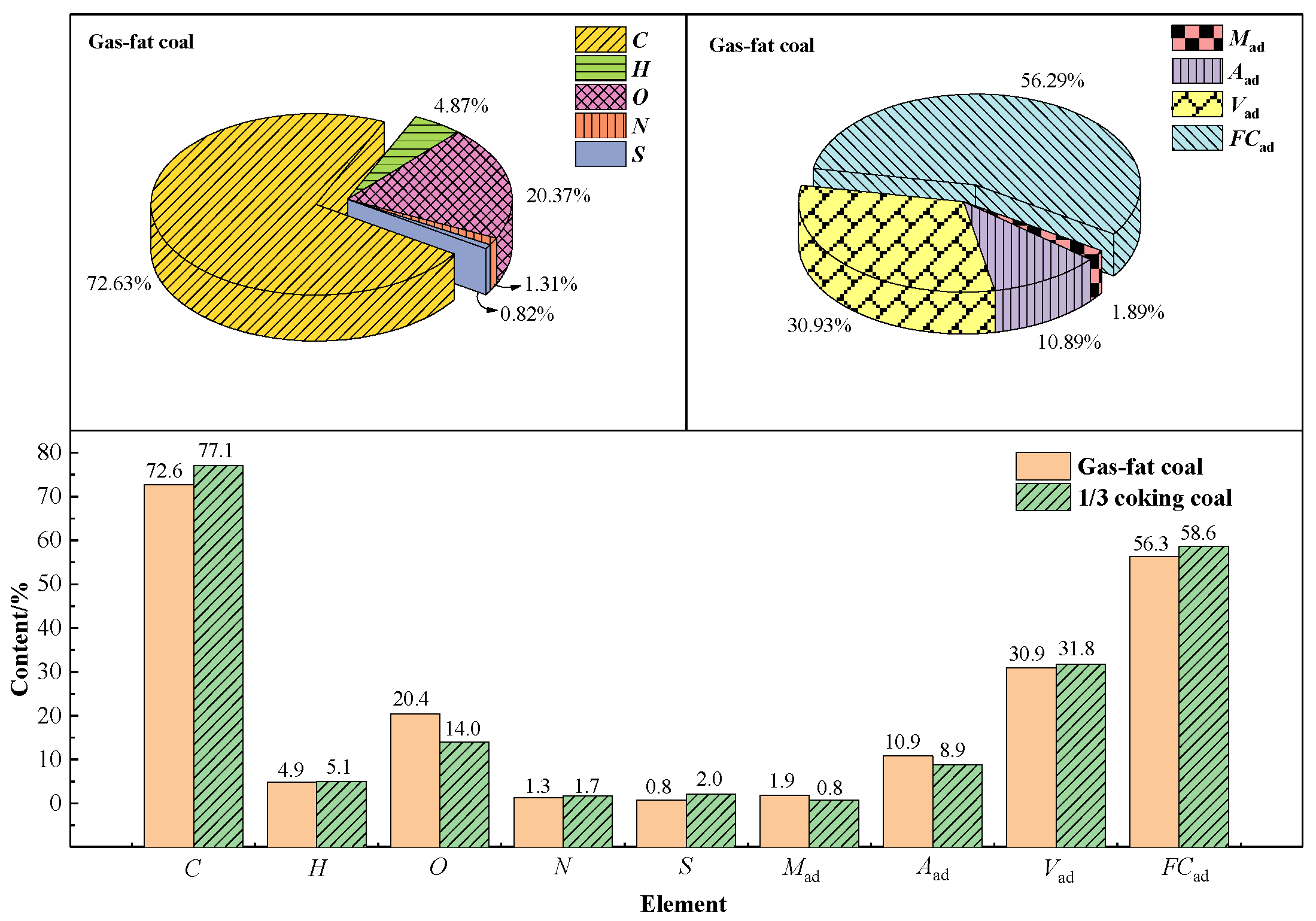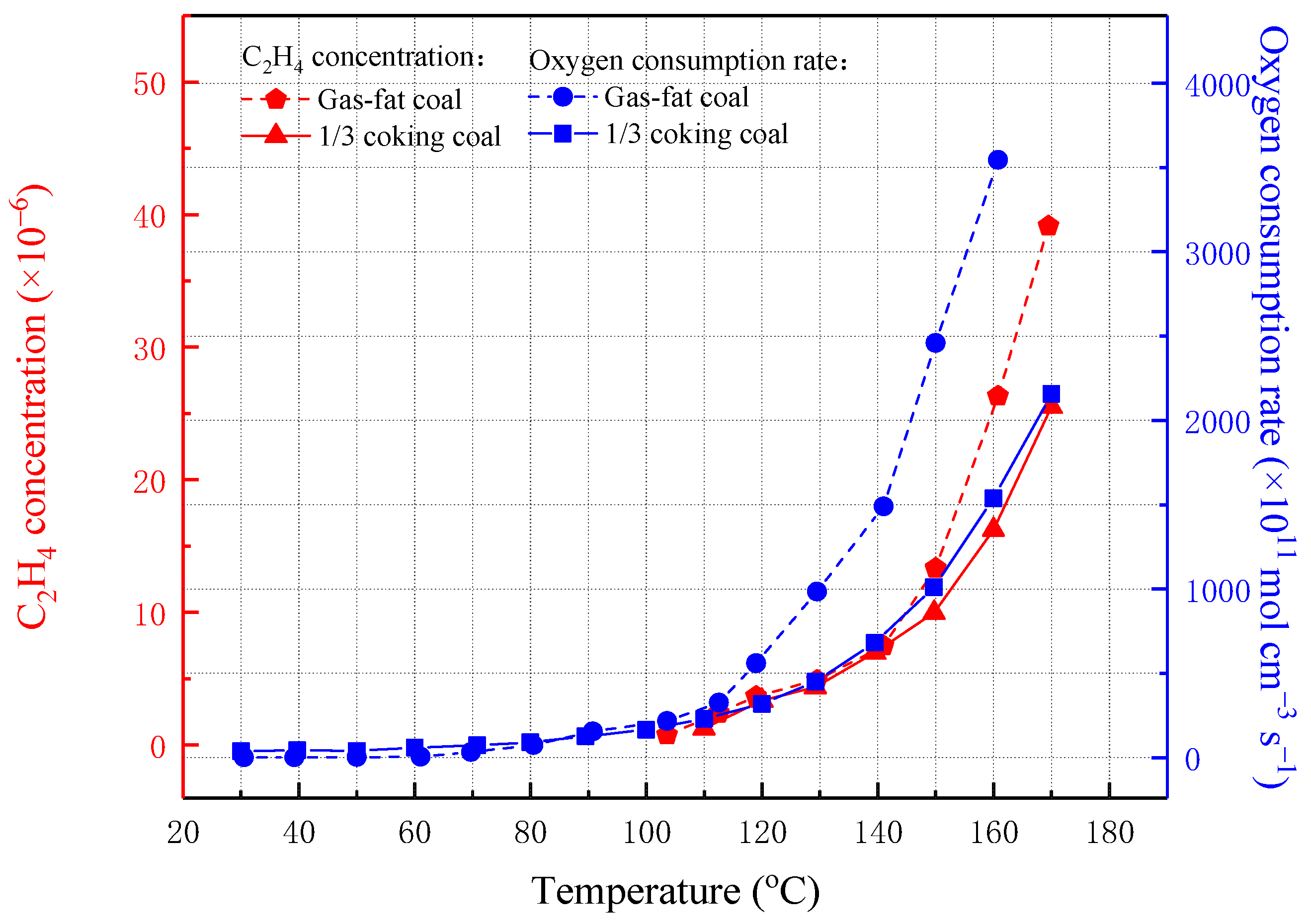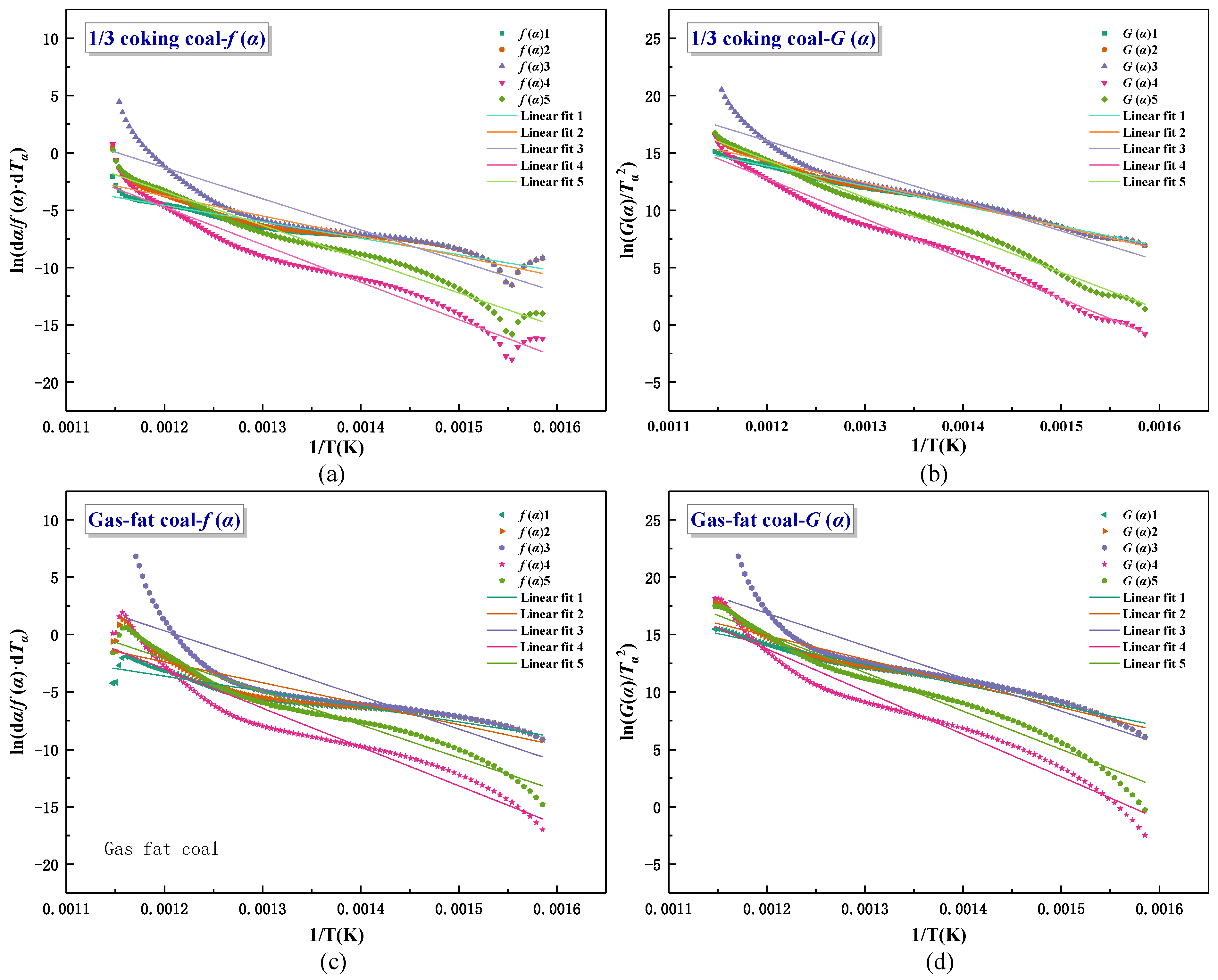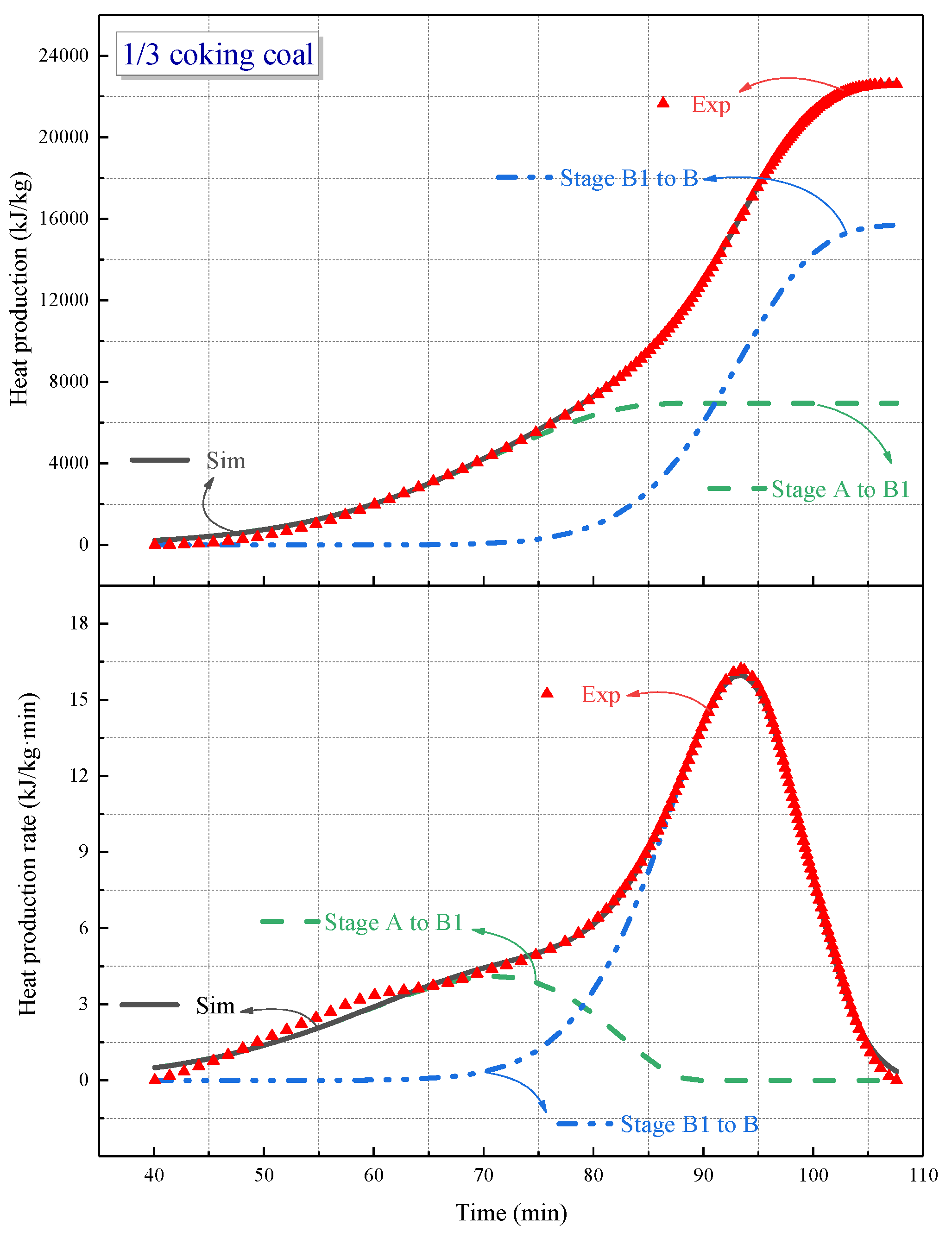Study of Gases and Thermal Behavior of Oxidized Coal during Spontaneous Combustion Process
Abstract
:1. Introduction
2. Experimental
2.1. Coal Samples
2.2. Proximate and Elemental Experiments
2.3. Physical Adsorption Experiments
2.4. Temperature-Programmed Experimental System
2.5. Differential Scanning Calorimetry (DSC)
3. Results and Discussion
3.1. Coal Quality Analysis
3.2. Surface Characteristic Analysis
3.3. Spontaneous Combustion Characteristic Parameters
3.3.1. Concentration of Index Gases
3.3.2. Characteristic Temperatures
3.3.3. Oxygen Consumption
3.4. Thermal Analysis of Oxidized Coal
3.5. Analysis of the Achar Differential and Coats-Redfern Integral Method
3.6. Thermokinetic Multiple Linear Regression Analysis
4. Conclusions
Author Contributions
Funding
Conflicts of Interest
References
- Lu, X.; Deng, J.; Xiao, Y.; Zhai, X.; Wang, C.; Yi, X. Recent progress and perspective on thermal-kinetic, heat and mass transportation of coal spontaneous combustion hazard. Fuel 2022, 308, 121234. [Google Scholar] [CrossRef]
- Liang, Y.; Zhang, J.; Wang, L.; Luo, H.; Ren, T. Forecasting spontaneous combustion of coal in underground coal mines by index gases: A review. J. Loss Prev. Process Ind. 2019, 57, 208–222. [Google Scholar] [CrossRef]
- Zhang, J.; Xu, K.; Reniers, G.; You, G. Statistical analysis the characteristics of extraordinarily severe coal mine accidents (ESCMAs) in China from 1950 to 2018. Process Saf. Environ. Prot. 2020, 133, 332–340. [Google Scholar] [CrossRef]
- Xu, Q.; Yang, S.; Yang, W.; Tang, Z.; Hu, X.; Song, W.; Zhou, B.; Yang, K. Secondary oxidation of crushed coal based on free radicals and active groups. Fuel 2021, 290, 120051. [Google Scholar] [CrossRef]
- Taraba, B.; Michalec, Z. Effect of longwall face advance rate on spontaneous heating process in the gob area—CFD modelling. Fuel 2011, 90, 2790–2797. [Google Scholar] [CrossRef]
- Melody, S.M.; Johnston, F.H. Coal mine fires and human health: What do we know? Int. J. Coal Geol. 2015, 152, 1–14. [Google Scholar] [CrossRef]
- Biswal, S.S.; Gorai, A.K. Change detection analysis in coverage area of coal fire from 2009 to 2019 in Jharia Coalfield using remote sensing data. Int. J. Remote Sens. 2020, 41, 9545–9564. [Google Scholar] [CrossRef]
- Chen, G.; Ma, X.; Lin, M.; Peng, X.; Yu, Z. Pollutant emission characteristics and interaction during low-temperature oxidation of blended coal. J. Energy Inst. 2016, 89, 40–47. [Google Scholar] [CrossRef]
- Li, J.; Li, Z.; Yang, Y.; Duan, Y.; Xu, J.; Gao, R. Examination of CO, CO2 and active sites formation during isothermal pyrolysis of coal at low temperatures. Energy 2019, 185, 28–38. [Google Scholar] [CrossRef]
- Prodan, M.; Mitu, M.; Razus, D.; Oancea, D. Spark ignition and propagation properties of methane-air mixtures from early stages of pressure history. Rev. Roum. Chim. 2016, 61, 299–305. [Google Scholar]
- Prodan, M.; Ghicioi, E.; Jurca, A.; Oancea, D. Ignition and propagation properties of coal dust-air-methane hybrid mixtures. Rev. Roum. Chim. 2021, 66, 25–32. [Google Scholar] [CrossRef]
- Zhang, J.; Ren, T.; Liang, Y.; Wang, Z. A review on numerical solutions to self-heating of coal stockpile: Mechanism, theoretical basis, and variable study. Fuel 2016, 182, 80–109. [Google Scholar] [CrossRef]
- Wang, H.; Dlugogorski, B.Z.; Kennedy, E.M. Coal oxidation at low temperatures: Oxygen consumption, oxidation products, reaction mechanism and kinetic modelling. Prog. Energy Combust. Sci. 2003, 29, 487–513. [Google Scholar] [CrossRef]
- Chen, W.Y.; Shi, G.; Wan, S. Characterization of early-stage coal oxidation by temperature-programmed desorption. Energy Fuels 2008, 22, 3724–3735. [Google Scholar] [CrossRef]
- Xin, H.H.; Wang, D.M.; Qi, X.Y.; Qi, G.S.; Dou, G.L. Structural characteristics of coal functional groups using quantum chemistry for quantification of infrared spectra. Fuel Process. Technol. 2014, 118, 287–295. [Google Scholar] [CrossRef]
- Zheng, Y.; Li, Q.; Lin, B.; Zhou, Y.; Liu, Q.; Zhang, G.; Zhao, Y. Real-time analysis of the changing trends of functional groups and corresponding gas generated law during coal spontaneous combustion. Fuel Process. Technol. 2020, 199, 106237. [Google Scholar] [CrossRef]
- Zhong, X.; Kan, L.; Xin, H.; Qin, B.; Dou, G. Thermal effects and active group differentiation of low-rank coal during low-temperature oxidation under vacuum drying after water immersion. Fuel 2019, 236, 1204–1212. [Google Scholar] [CrossRef]
- Wang, D.M. Mine Fire Science; China University of Mining and Technology Press: Beijing, China, 2008. (In Chinese) [Google Scholar]
- Qi, G.; Wang, D.; Zheng, K.; Xu, J.; Qi, X.; Zhong, X. Kinetics characteristics of coal low-temperature oxidation in oxygen-depleted air. J. Loss Prev. Process Ind. 2015, 35, 224–231. [Google Scholar] [CrossRef]
- Li, Q.W.; Xiao, Y.; Wang, C.P.; Deng, J.; Shu, C.M. Thermokinetic characteristics of coal spontaneous combustion based on thermogravimetric analysis. Fuel 2019, 250, 235–244. [Google Scholar] [CrossRef]
- Zhong, X.; Li, L.; Chen, Y.; Dou, G.; Xin, H. Changes in thermal kinetics characteristics during low-temperature oxidation of low-rank coals under lean-oxygen conditions. Energy Fuels 2017, 31, 239–248. [Google Scholar] [CrossRef]
- Li, Y.; Zhao, H.; Song, Q.; Wang, X.; Shu, X. Influence of critical moisture content in lignite dried by two methods on its physicochemical properties during oxidation at low temperature. Fuel 2018, 211, 27–37. [Google Scholar] [CrossRef]
- Liang, Y.; Tian, F.; Guo, B.; Liu, Z. Experimental investigation on microstructure evolution and spontaneous combustion properties of aerobic heated coal. Fuel 2021, 306, 121766. [Google Scholar] [CrossRef]
- Zhang, Y.N.; Chen, L.; Deng, J.; Zhao, J.Y.; Li, H.T.; Yang, H. Influence of granularity on thermal behaviour in the process of lignite spontaneous combustion. J. Therm. Anal. Calorim. 2019, 135, 2247–2255. [Google Scholar] [CrossRef]
- Deng, J.; Xiao, Y.; Li, Q.; Lu, J.; Wen, H. Experimental studies of spontaneous combustion and anaerobic cooling of coal. Fuel 2015, 157, 261–269. [Google Scholar] [CrossRef]
- Song, Z.; Wu, D.; Jiang, J.; Pan, X. Thermo-solutal buoyancy driven air flow through thermally decomposed thin porous media in a U-shaped channel: Towards understanding persistent underground coal fires. Appl. Therm. Eng. 2019, 159, 113948. [Google Scholar] [CrossRef]
- Su, H.; Zhou, F.; Song, X.; Qiang, Z. Risk analysis of spontaneous coal combustion in steeply inclined longwall gobs using a scaled-down experimental set-up. Process Saf. Environ. Prot. 2017, 111, 1–12. [Google Scholar] [CrossRef]
- Xia, T.; Zhou, F.; Liu, J.; Kang, J.; Gao, F. A fully coupled hydro-thermo-mechanical model for the spontaneous combustion of underground coal seams. Fuel 2014, 125, 106–115. [Google Scholar] [CrossRef]
- Song, Z.Y.; Zhu, H.Q.; Tan, B.; Wang, H.Y.; Qin, X.F. Numerical study on effects of air leakages from abandoned galleries on hill-side coal fires. Fire Saf. J. 2014, 69, 99–110. [Google Scholar] [CrossRef]
- Tang, Y.; Zhong, X.; Li, G.; Yang, Z.; Shi, G. Simulation of dynamic temperature evolution in an underground coal fire area based on an optimized Thermal–Hydraulic–Chemical model. Combust. Theor. Model. 2019, 23, 127–146. [Google Scholar] [CrossRef]
- Zhang, Y.; Zhang, Y.; Li, Y.; Li, Q.; Zhang, J.; Yang, C. Study on the characteristics of coal spontaneous combustion during the development and decaying processes. Process Saf. Environ. Prot. 2020, 138, 9–17. [Google Scholar] [CrossRef]
- Qi, G.; Lu, W.; Qi, X.; Zhong, X.; Cheng, W.; Liu, F. Differences in smoldering characteristics of coal piles with different smoldering propagation directions. Fire Saf. J. 2018, 102, 77–82. [Google Scholar]
- Xiao, Y.; Ye, X.X.; Liu, K.H.; Chen, L.G. Transformation law of key functional groups in the process of coal secondary oxidation. J. China Coal Soc. 2021, 46, 989–1000. [Google Scholar]
- Zhao, J.; Deng, J.; Wang, T.; Song, J.; Zhang, Y.; Shu, C.M.; Zeng, Q. Assessing the effectiveness of a high-temperature-programmed experimental system for simulating the spontaneous combustion properties of bituminous coal through thermokinetic analysis of four oxidation stages. Energy 2019, 169, 587–596. [Google Scholar] [CrossRef]
- Yi, L.; Feng, J.; Qin, Y.H.; Li, W.Y. Prediction of elemental composition of coal using proximate analysis. Fuel 2017, 193, 315–321. [Google Scholar] [CrossRef]
- Wang, Y.S.; Xue, G.F.; Bao, J.F.; Ren, Y.M. Analysis on residual coke during medium maintenance of No.6 blast furnace of Wusteel. Iron Steel 2016, 50, 20–24. [Google Scholar]
- Slepetiene, A.; Slepetys, J.; Liaudanskiene, I. Chemical composition of differently used Terric Histosol. Zemdirbyste 2010, 97, 25–32. [Google Scholar]
- Wu, H.; Yang, N.; Tang, Y.; Jiang, J.C.; Huang, A.C. Thermal Stability Evaluation of T152 Emulsifier on the Modification Influence of Fireworks Propellant. Processes 2022, 10, 1606. [Google Scholar] [CrossRef]
- Zhang, C.Z.; Xie, L.J.; Tang, Y.; Li, Y.; Jiang, J.C.; Huang, A.C. Thermal Safety Evaluation of Silane Polymer Compounds as Electrolyte Additives for Silicon-Based Anode Lithium-Ion Batteries. Processes 2022, 10, 1581. [Google Scholar] [CrossRef]
- Qi, D.; Wu, S.; Li, S.; Zhao, G.; Xing, J.; Kang, S.; Wang, Q.; Gao, W. Enrichment Characteristics, Occurrence and Origin of Valuable Trace Elements in Lignite from Linchang Coal Mine, Guangxi, China. J. Geosci. Environ. Prot. 2021, 9, 133–150. [Google Scholar] [CrossRef]
- Ma, Y. Multiscale Fractal Characterization of Pore Structure for Coal in Different Rank Using Scanning Electron Microscopy and Mercury Intrusion Porosimetry. Processes 2022, 10, 1577. [Google Scholar] [CrossRef]
- Chen, X.; Li, H.; Wang, Q.; Zhang, Y. Experimental investigation on the macroscopic characteristic parameters of coal spontaneous combustion under adiabatic oxidation conditions with a mini combustion furnace. Combust. Sci. Technol. 2018, 190, 1075–1095. [Google Scholar] [CrossRef]
- Dong, X.W.; Wen, Z.C.; Wang, F.S.; Meng, Y.N. Law of gas production during coal heating oxidation. Int. J. Min. Sci. Technol. 2019, 29, 617–620. [Google Scholar] [CrossRef]
- Lin, B.; Li, Q.; Zhou, Y. Research advances about multi-field evolution of coupled thermodynamic disasters in coal mine goaf. J. China Coal Soc. 2021, 46, 1715–1725. [Google Scholar]
- Deng, J.; Wu, X.; Cheng, C. Experimental study on explosion of multicomponent combustibility gases containing CH4, CO and C2H4. Coal Mine Mod. 2007, 5, 63–65. [Google Scholar]
- Xie, L.J.; Jiang, J.C.; Huang, A.C.; Tang, Y.; Liu, Y.C.; Zhou, H.L.; Xing, Z.X. Calorimetric evaluation of thermal stability of organic liquid hydrogen storage materials and metal oxide additives. Energies 2022, 15, 2236. [Google Scholar] [CrossRef]
- Yang, Y.P.; Jiang, J.C.; Huang, A.C.; Tang, Y.; Liu, Y.C.; Xie, L.J.; Zhang, C.Z.; Wu, Z.H.; Xing, Z.X.; Yu, F. 3-(Trifluoromethyl) benzoylacetonitrile: A multi-functional safe electrolyte additive for LiNi0.8Co0.1Mn0.1O2 cathode of high voltage lithium-ion battery. Process Saf. Environ. Prot. 2022, 160, 80–90. [Google Scholar] [CrossRef]
- Yang, Y.; Ding, L.; Xu, L.; Tsai, Y.T. Effect of metal chloride on thermal decomposition of nitrocellulose. Case Stud. Therm. Eng. 2021, 28, 101667. [Google Scholar] [CrossRef]
- Zhang, C.Z.; Jiang, J.C.; Huang, A.C.; Tang, Y.; Xie, L.J.; Zhai, J.; Xing, Z.X. A novel multifunctional additive strategy improves the cycling stability and thermal stability of SiO/C anode Li-ion batteries. Process Saf. Environ. Prot. 2022, 164, 555–565. [Google Scholar] [CrossRef]
- Yao, C.; Liu, Y.C.; Wu, J.; Tang, Y.; Zhai, J.; Shu, C.M.; Jiang, J.C.; Xing, Z.X.; Huang, C.F.; Huang, A.C. Thermal Stability Determination of Propylene Glycol Sodium Alginate and Ammonium Sulfate with Calorimetry Technology. Processes 2022, 10, 1177. [Google Scholar] [CrossRef]
- Huang, A.C.; Huang, C.F.; Xing, Z.X.; Jiang, J.C.; Shu, C.M. Thermal hazard assessment of the thermal stability of acne cosmeceutical therapy using advanced calorimetry technology. Process Saf. Environ. Prot. 2019, 131, 197–204. [Google Scholar] [CrossRef]
- Shao, Z.; Wang, D.; Wang, Y.; Zhong, X.; Tang, X.; Hu, X. Controlling coal fires using the three-phase foam and water mist techniques in the Anjialing Open Pit Mine, China. Nat. Hazards 2015, 75, 1833–1852. [Google Scholar] [CrossRef]






| CO (ppm) | ||
|---|---|---|
| Temperature (°C) | Gas-Fat Coal | 1/3 Coking Coal |
| 30 | 24.53 | 9.55 |
| 40 | 24.25 | 21.53 |
| 50 | 48.87 | 48.96 |
| 60 | 75.97 | 74.83 |
| 70 | 131.00 | 158.90 |
| 80 | 200.90 | 310.50 |
| 90 | 348.80 | 491.70 |
| 100 | 574.30 | 904.00 |
| 110 | 898.10 | 1248.00 |
| 120 | 1403.00 | 1790.00 |
| 130 | 2114.00 | 2995.00 |
| 140 | 3403.00 | 5059.00 |
| 150 | 5045.00 | 7039.00 |
| 160 | 7442.00 | 10,340.00 |
| 170 | 9992.00 | 13,080.00 |
| Number | Reaction Mechanism | Differential Function f(α) | Integral Function G(α) |
|---|---|---|---|
| 1 | First-order chemical reaction, n = 1 | 1 − α | −ln(α) |
| 2 | 1.5 order chemical reaction, n = 1.5 | (1 − α)3/2 | 2[(1 − α)−1/2 − 1] |
| 3 | Third-order chemical reaction, n = 1.5 | (1 − α)3 | [(1 − α)−2 − 1]/2 |
| 4 | 3D diffusion Z.-L.-T. equation | 3/2(1 − α)4/3[(1 − α)−1/3 − 1]−1 | [(1 − α)−1/3 − 1]2 |
| 5 | Avrami–Eroféev, n = 2 | 1/2(1 − α)[−ln(1 − α)]−1 | [−ln(1 − α)]2 |
| Sample | Number | Eα (kJ/mol) | |||
|---|---|---|---|---|---|
| f(α) | G(α) | Average | Difference | ||
| Gas-fat coal | 1 | 60.19 | 83.25 | 71.72 | 23.06 |
| 2 | 80.39 | 95.21 | 87.80 | 14.82 | |
| 3 | 141.00 | 143.28 | 142.14 | 2.29 | |
| 4 | 153.73 | 170.91 | 162.32 | 17.18 | |
| 5 | 132.67 | 155.73 | 144.20 | 23.06 | |
| 1/3 coking coal | 1 | 64.71 | 81.17 | 72.94 | 16.47 |
| 2 | 79.08 | 89.44 | 84.26 | 10.36 | |
| 3 | 122.20 | 121.34 | 121.77 | 0.86 | |
| 4 | 150.01 | 162.21 | 162.21 | 12.20 | |
| 5 | 135.12 | 151.59 | 151.59 | 16.47 | |
| Parameters | Stage | ln(k0) (1/s) | Ea (kJ/mol) | n | ΔH (J/g) |
|---|---|---|---|---|---|
| Gas-fat coal | I | 4.946 | 62.70 | 1.342 | 5890.231 |
| II | 15.685 | 140.36 | 0.954 | 17,890.451 | |
| 1/3 coking coal | I | 2.170 | 49.00 | 0.709 | 6952.660 |
| II | 16.928 | 148.24 | 1.046 | 15,726.360 |
Publisher’s Note: MDPI stays neutral with regard to jurisdictional claims in published maps and institutional affiliations. |
© 2022 by the authors. Licensee MDPI, Basel, Switzerland. This article is an open access article distributed under the terms and conditions of the Creative Commons Attribution (CC BY) license (https://creativecommons.org/licenses/by/4.0/).
Share and Cite
Tang, Y.; Chen, W.-C.; Zhou, H.-L.; Zhao, J.-Y.; Shu, C.-M.; Huang, A.-C. Study of Gases and Thermal Behavior of Oxidized Coal during Spontaneous Combustion Process. Processes 2022, 10, 1849. https://doi.org/10.3390/pr10091849
Tang Y, Chen W-C, Zhou H-L, Zhao J-Y, Shu C-M, Huang A-C. Study of Gases and Thermal Behavior of Oxidized Coal during Spontaneous Combustion Process. Processes. 2022; 10(9):1849. https://doi.org/10.3390/pr10091849
Chicago/Turabian StyleTang, Yan, Wei-Chun Chen, Hai-Lin Zhou, Jing-Yu Zhao, Chi-Min Shu, and An-Chi Huang. 2022. "Study of Gases and Thermal Behavior of Oxidized Coal during Spontaneous Combustion Process" Processes 10, no. 9: 1849. https://doi.org/10.3390/pr10091849
APA StyleTang, Y., Chen, W.-C., Zhou, H.-L., Zhao, J.-Y., Shu, C.-M., & Huang, A.-C. (2022). Study of Gases and Thermal Behavior of Oxidized Coal during Spontaneous Combustion Process. Processes, 10(9), 1849. https://doi.org/10.3390/pr10091849








